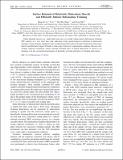| dc.contributor.author | Li, Qing-Jie | |
| dc.contributor.author | Li, Ju | |
| dc.contributor.author | Shan, Zhi-Wei | |
| dc.contributor.author | Ma, Evan | |
| dc.date.accessioned | 2017-06-14T17:54:24Z | |
| dc.date.available | 2017-06-14T17:54:24Z | |
| dc.date.issued | 2016-10 | |
| dc.date.submitted | 2016-08 | |
| dc.identifier.issn | 0031-9007 | |
| dc.identifier.issn | 1079-7114 | |
| dc.identifier.uri | http://hdl.handle.net/1721.1/109861 | |
| dc.description.abstract | Under ultrahigh stresses (e.g., under high strain rates or in small-volume metals) deformation twinning (DT) initiates on a very short time scale, indicating strong spatial-temporal correlations in dislocation dynamics. Using atomistic simulations, here we demonstrate that surface rebound of relativistic dislocations directly and efficiently triggers DT under a wide range of laboratory experimental conditions. Because of its stronger temporal correlation, surface rebound sustained relay of partial dislocations is shown to be dominant over the conventional mechanism of thermally activated nucleation of twinning dislocations. | en_US |
| dc.description.sponsorship | National Science Foundation (U.S.) (Grant DMR-1410636) | en_US |
| dc.publisher | American Physical Society | en_US |
| dc.relation.isversionof | http://dx.doi.org/10.1103/PhysRevLett.117.165501 | en_US |
| dc.rights | Article is made available in accordance with the publisher's policy and may be subject to US copyright law. Please refer to the publisher's site for terms of use. | en_US |
| dc.source | American Physical Society | en_US |
| dc.title | Surface Rebound of Relativistic Dislocations Directly and Efficiently Initiates Deformation Twinning | en_US |
| dc.type | Article | en_US |
| dc.identifier.citation | Li, Qing-Jie et al. “Surface Rebound of Relativistic Dislocations Directly and Efficiently Initiates Deformation Twinning.” Physical Review Letters 117.16 (2016): n. pag. © 2016 American Physical Society | en_US |
| dc.contributor.department | Massachusetts Institute of Technology. Department of Nuclear Science and Engineering | en_US |
| dc.contributor.mitauthor | Li, Ju | |
| dc.relation.journal | Physical Review Letters | en_US |
| dc.eprint.version | Final published version | en_US |
| dc.type.uri | http://purl.org/eprint/type/JournalArticle | en_US |
| eprint.status | http://purl.org/eprint/status/PeerReviewed | en_US |
| dc.date.updated | 2016-10-11T22:00:05Z | |
| dc.language.rfc3066 | en | |
| dc.rights.holder | American Physical Society | |
| dspace.orderedauthors | Li, Qing-Jie; Li, Ju; Shan, Zhi-Wei; Ma, Evan | en_US |
| dspace.embargo.terms | N | en_US |
| dc.identifier.orcid | https://orcid.org/0000-0002-7841-8058 | |
| mit.license | PUBLISHER_POLICY | en_US |
| mit.metadata.status | Complete | |
